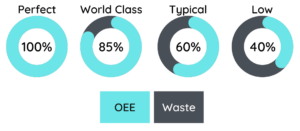Chapter 4: Total Productive Maintenance
Overview
Total Productive Maintenance is a “holistic approach to equipment maintenance that strives to achieve perfect production” (Lean Production, 2021). TPM does this by preventing breakdown, eliminating elements that slow down the process, and perfects production so defects and accidents do not occur. TPM promotes operational efficiency through proactive and preventative maintenance. The employees are empowered to keep their specific equipment in top shape. TPM’s foundation is 5S, so organization is a vital component to its success (Lean Production, 2021). There are six major equipment losses that are monitored through OEE. (Mothilal & Prakash, 2018).
Typical Plant Maintenance Stages
TPM has three maintenance stages: breakdown maintenance, preventative maintenance, and preventative and predictive maintenance.
- Breakdown maintenance requires very little team involvement, employees complete the maintenance themselves.
- Preventative maintenance has more team members involved as machines are regularly checked and maintained.
- TPM (preventative and predictive maintenance) involves the entire team to be proactive and regularly schedule maintenance to keep the production line running smoothly.
Overall Equipment Effectiveness (OEE)
Overall Equipment Effectiveness (OEE) is the standard for measuring productivity. Through the use of data, anyone can calculate the amount of manufacturing planned time that is productive. It was developed to support TPM initiatives by accurately tracking progress towards achieving the goal of perfect production. Three items are involved in calculating OEE: , , and . OEE is calculated by multiplying each item (availability x performance efficiency x quality rate) (Mothilal & Prakash, 2018; Candra et al., 2017). Below are each of the formulas that contribute to the calculation of OEE. Beneath each calculation, there is information about the losses each category may sustain in production. There are two losses per category, representing the six major losses effecting manufacturers. It may be beneficial to read more thoroughly about TPM by following this link to Lean Production (2021).
Availability = Run Time / Planned Production Time
- There are two significant losses in this category including unplanned loss and setup/adjustments. These events stop production for a period of time, be it a little or a lot (Lean Production, 2021).
Performance = (Ideal Cycle Time x Total Count) / Run Time
- There are two significant types of performance loss including small stops and slow running. These items cause production to run less than its maximum speed (Lean Production, 2021).
Quality = Good Count / Total Count
- The two significant types of loss in regards to quality are those items that are produce that do not meet standards (defective) or those that require extra time to be reworked. (Lean Production, 2021).

Test Yourself Example 1:
Using the metrics below, calculate OEE for Little Things Toy Manufacturer and select the correct answer.
Metrics:
- Planned Production Time: 450 minutes
- Changeover: 50 minutes
- Other Downtime: 40 minutes
- Best Cycle Time: 1 part/minute
- Number of parts produced: 342
- Number of non-conforming parts: 17
Test Yourself Example 2:
Using the metrics below, calculate OEE for Tubes Pipe Manufacturer and select the correct answer.
Metrics:
- Planned Production Time: 480 minutes
- Changeover: 60 minutes
- Other Downtime: 30 minutes
- Best Cycle Time: 12 sec (.20 minutes/part)
- Number of parts produced: 1800
- Number of non-conforming parts: 18
Reflection
Review the examples and answer the following questions:
- Are either of these companies performing at World Class OEE?
- Where are the biggest losses?
References:
Candra, N., Susilawati, A., Herisiswanto, & Setiady, W. (2017). Implementation of total productive maintenance (TPM) to improve sheeter machine performance. MATEC Web of Conferences, 135. DOI: 10.1051/matecconf/201713500028
Dennis, P. (2016). Lean production simplified : a plain-language guide to the world’s most powerful production system (Third). CRC Press, Taylor & Francis Group.
Lean Production (2021). TPM (Total productive maintenance). Lean Production. https://www.leanproduction.com/tpm/
Mothilal, B. & Prakash C. (2018). Implementation of lean tools in apparel industry to improve productivity and quality. Current Trends in Fashion Technology and Textile Engineering, 4(1). DOI: 10.19080/CTFTTE.2018.04.555628
“Overall Equipment Effectiveness” (2021). OEE. https://www.oee.com/
a measure of uptime
measure during machine run time
percentage of good production

